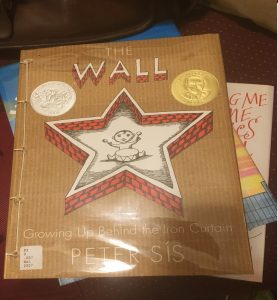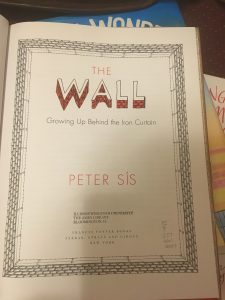Author(s), Illustrator/Photographer: Peter Sís.
Publisher and Year Number of pages: Frances Foster Books, 2005, 50 Pages.

Descriptive Annotation: The cover features two awards-one Caldecott, and one Robert Siebert, along with a Czech baby in the middle of a giant red star. As a send-up of the sort of books the Soviet and Communist presses made during the Cold War, there are many parodies of Communist Party imagery, the red star on the cover being the first example. This is a combination of both standard Soviet imagery and the kind of cartoons and political drawings that appeared in plentiful quantities in the Prague Spring of 1968, in which control by the Czechoslovak Communist regime was briefly loosened and the free press came roaring back temporarily. The wall is the story of that spring and the effect it had on the author, a Czech-American man and his visit that he took to his homeland with the children he raised in the United States. Their experiences in the city of Prague are much different than those of their father’s: “Now when my American family goes to visit my Czech family in the colorful city of Prague, it is hard to convince them it was ever a dark place full of fear, suspicion and lies” (Sis, p. 49). As his childhood under Communist rule is described to the reader by the use of comic strips on the top of the page and captions on the bottom, Sis also continues to express the fears that tormented him as a young man in the old country, and how he and his family didn’t talk about certain things for fear of the secret police hearing them. The whole of his trials, from growing up in the tightly repressed Czechoslovakia, to experiencing true freedom in the second half of the 1960’s and the subsequent Soviet invasion in August of 1968 and the ways in which the population react (or don’t react) to the actions the Red regime takes against the previously free media and citizenry, are covered in the book. Prior knowledge of what the Cold War and Prague Spring were would certainly be useful in the scenario of students reading this book in the classroom.
Classroom Application: In this picture book, the comic strips depict what is and what is not permitted by the Soviet puppet government at various stages of its existence, which would be ideal for some social studies settings which have students that perhaps had relatives behind the Iron Curtain back in the day, and didn’t get to experience some of the freedoms that we as Americans take for granted. This is a teachable moment since it’s Sis’s way of saying that his life in Czechoslovakia in the 1960s through the 1980s was so drastically different from what students today have to experience (mandatory participation in a scouting movement and collection of scrap metals), it can be hard to teach in some ways. We must try as educators to do so, however, because if we don’t, the same mistakes of the past could easily be repeated again.
Linguistic and Cultural Diversity Analysis: Sis covers the different ways in which the Cold War and Prague Spring are remembered, showing the contrast between East and West through maps and exclaiming what a unique experience having the Beatles and Beach Boys was in his country: “But out of the dark came a glimmer of hope. The Beach Boys arrived. America to the rescue!” (Sis, p. 27-28). Exasperated with the new youth movement and fearful that the colorful styles of the West will destroy their socialist paradise, the Czechoslovak police maul and arrest concertgoers who saw the Beach Boys at Prague’s Lucerna Hall in 1969 as they leave. The return of people not being able to get the music they want from the West through traditional means results in a huge black market forming, one that persists in Sis’s telling until his departure for the US in 1984. This should be a widely taught and used piece of work, both in the US and around the former Eastern Bloc, since it shows the profound failure of the latter and the absolute oppression which results from authoritarianism. In the context of the experience of Sis’s family and millions of others, it is necessary that they are brought some peace of mind that this kind of system can never rear its ugly head again and make people scared to live their lives in peace. Artists like Sis, who was a radio DJ and actually toured with the Beach Boys when they visited his country, can never be truly suppressed by the jackboot of hate, but they need our help whenever possible to keep their creative flames alive.

